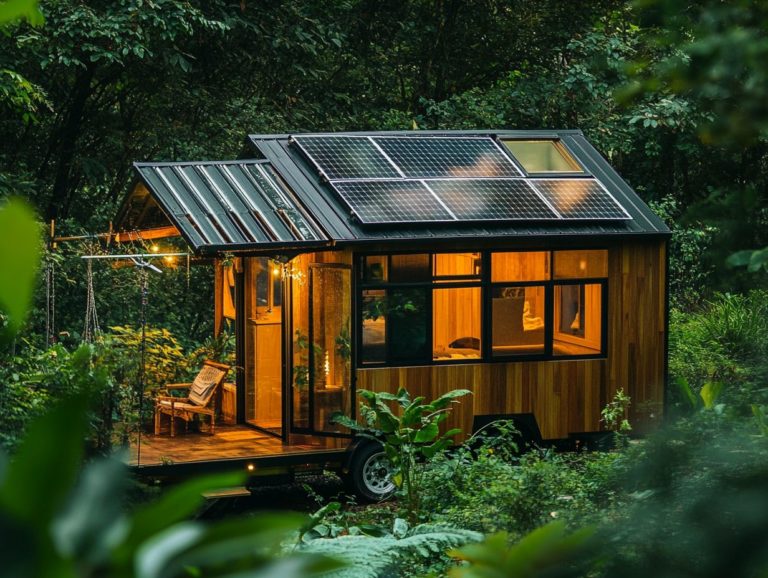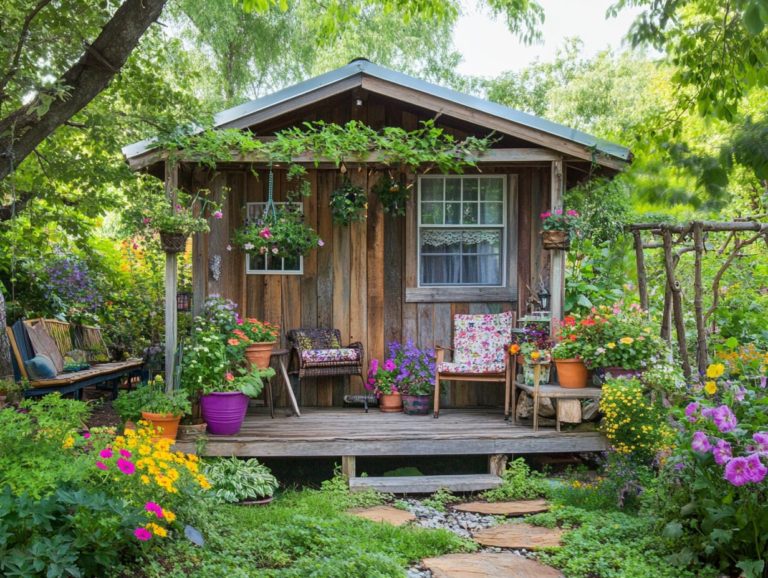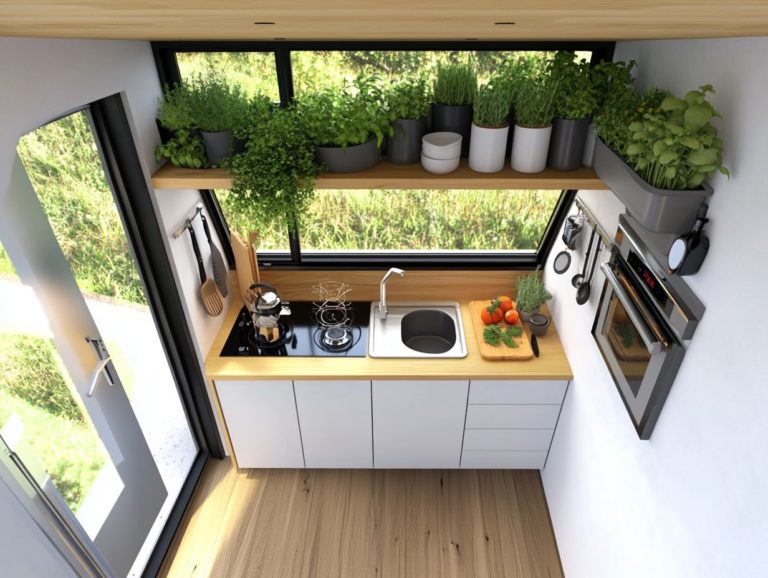DIY Projects for Maximizing Tiny House Efficiency
Tiny houses are more than just a trend; they represent a simple and sustainable way of living.
For you, maximizing efficiency in these compact spaces is essential for creating a comfortable and functional home.
Get ready to explore exciting design ideas, clever space-saving tips, and fun DIY projects that will empower you to make the most of your tiny living environment.
From optimizing vertical space to integrating energy-efficient solutions, you’ll discover how to transform your tiny house into a beacon of efficiency and creativity.
Contents [hide]
- Key Takeaways:
- Designing for Efficiency
- DIY Storage Solutions
- Energy Efficiency in Tiny Houses
- Alternative Energy Sources
- Water Efficiency in Tiny Houses
- Maximizing Natural Light
- Frequently Asked Questions
- 1. What are some simple DIY projects for maximizing tiny house efficiency?
- 2. How can I make my tiny house feel more spacious with DIY projects?
- 3. Can I use recycled materials for DIY projects in my tiny house?
- 4. Are there any DIY projects for maximizing kitchen efficiency in a tiny house?
- 5. Can DIY projects help save energy in a tiny house?
- 6. What are some cost-effective DIY projects for maximizing tiny house efficiency?
Key Takeaways:
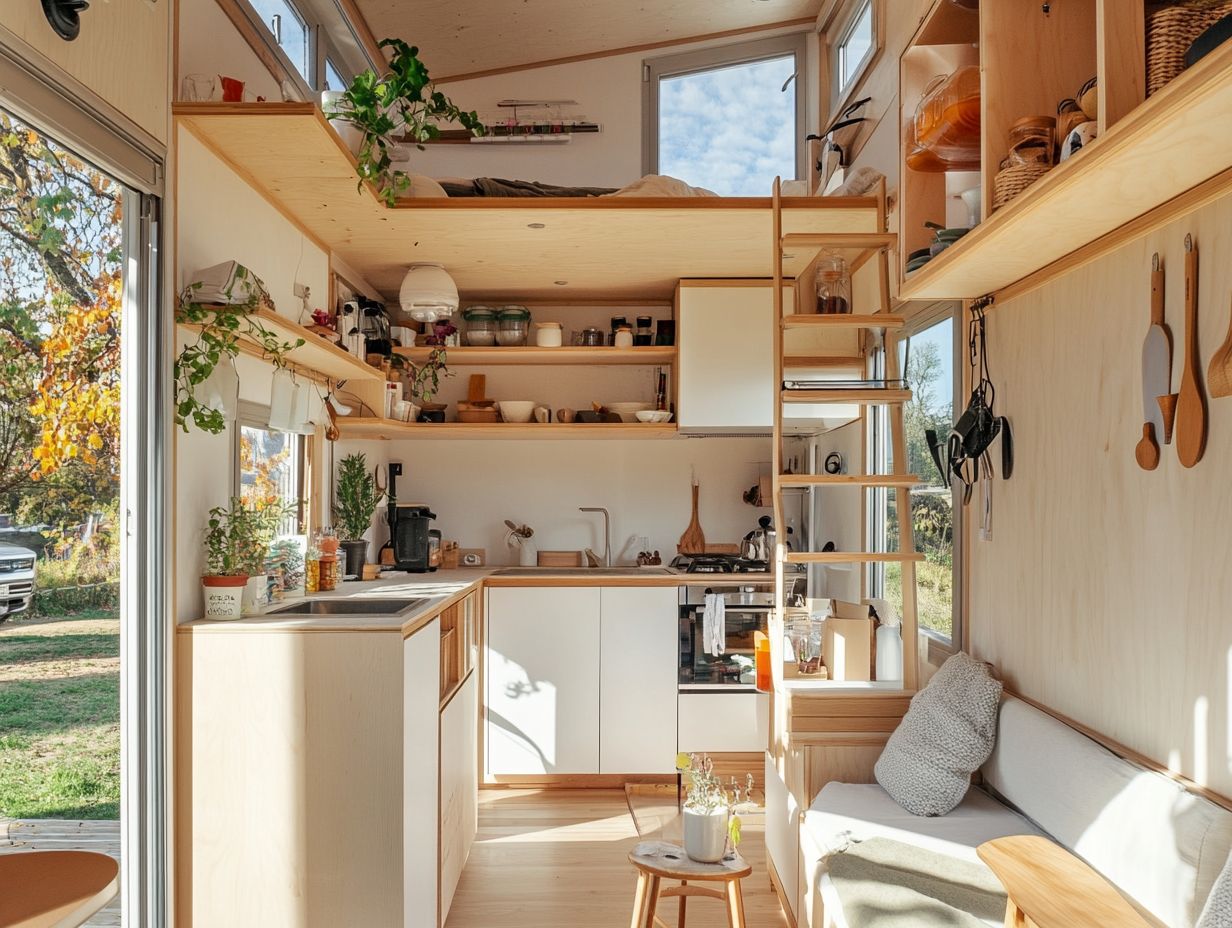
- Maximize your space to make the most of your tiny home.
- Incorporate creative storage solutions and let natural light in.
- Reduce energy and water use to boost sustainability.
The Benefits of Tiny House Efficiency
Maximizing efficiency in tiny houses is crucial for sustainable living, as these compact homes offer distinct advantages like lower energy consumption and fewer construction challenges.
Thoughtful planning and innovative design ensure that every square foot serves a purpose, which can be tricky, especially when considering local building regulations. To maximize space, consider making the most of vertical space in tiny houses. Using materials like reclaimed wood and insulated windows helps save energy while keeping your home cozy.
Embracing renewable energy sources like solar panels amplifies the ecological benefits of tiny living. As minimalism gains popularity, focusing on efficiency aligns with your lifestyle choices and contributes to sustainable urban development.
Designing for Efficiency
Designing for efficiency in tiny houses requires careful planning and a keen understanding of maximizing every inch of space while incorporating energy-saving features. From drafting your plans to selecting insulation materials and building a solid floor structure, your choices directly impact the overall efficiency of your tiny home.
Space-Saving Tips and Tricks
Implementing space-saving tips and tricks can greatly enhance the functionality of your tiny house, especially when considering the number of occupants and their storage needs. By planning your layouts strategically and incorporating clever storage solutions, you can maximize every inch of your compact living space.
For example, multifunctional furniture like sofa beds and extendable dining tables allows you to quickly adapt your areas for various activities, ensuring both comfort and utility. Vertical storage solutions, such as floating shelves and wall-mounted cabinets, save valuable floor space while keeping your living areas organized. Under-bed storage options, including drawers or bins, make efficient use of otherwise wasted space.
Many tiny homes showcase these strategies beautifully; one popular design features a slide-out table that doubles as a workspace, while another incorporates built-in shelving that reaches up to the ceiling, effortlessly blending style with functionality. For more inspiration, check out these smart design solutions for tiny house living.
Using Vertical Space
Using vertical space is a game-changer in tiny house design! It helps maintain a sense of openness while maximizing storage and practicality within compact interiors. By placing shelves on walls and making thoughtful lighting choices, you can elevate the ambiance and functionality of your living area.
In addition to shelves, incorporating vertical gardens can transform bare walls into lush living spaces. This not only enhances aesthetics but also improves air quality. Vertical gardens offer visual appeal while serving as a sustainable source of fresh herbs and vegetables.
Integrating these methods with features like composting toilets achieves a harmonious balance between eco-friendly practices and space efficiency. For example, using wall-mounted planters above utility areas allows you to incorporate greenery without sacrificing precious floor space.
Cleverly designed storage solutions can hide waste management systems, helping maintain an uncluttered environment.
DIY Storage Solutions
DIY storage solutions are crucial for maximizing the limited space in your tiny house! They allow you to create both functional and stylish storage that caters to your unique needs.
Using materials such as hardwood and plywood, you can design clever storage options. This not only enhances the efficiency of your tiny home but also ensures optimal trailer insulation.
Creative Storage Ideas
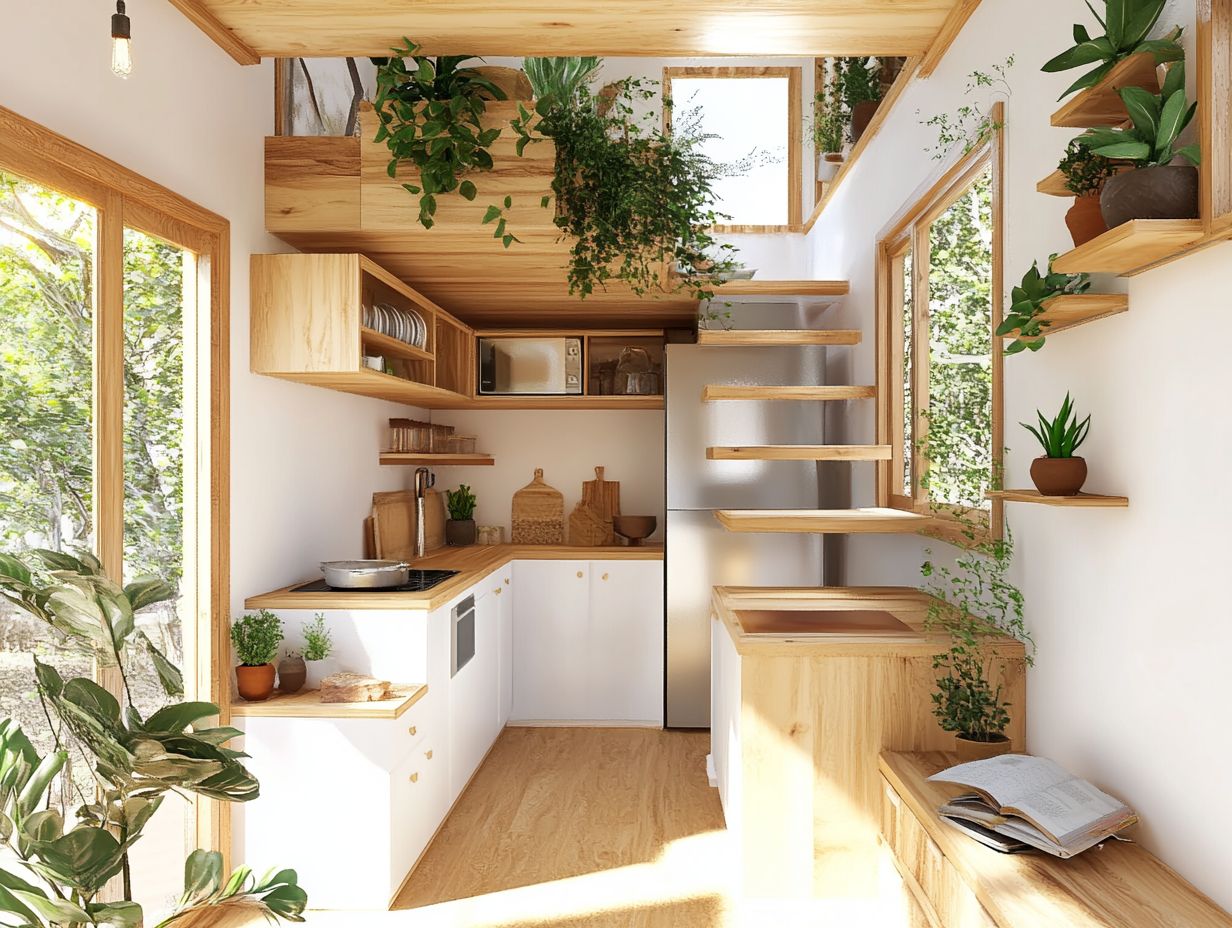
Creative storage ideas are essential for keeping an organized and efficient living space in tiny houses. Given the limited square footage and the necessity for energy-efficient designs, innovative solutions like under-cabinet storage in the kitchen can significantly enhance functionality! Plus, they ensure compliance with building codes for insulation, such as using Tyvek, a material that helps keep moisture out of walls.
Consider adding hidden compartments within your furniture. This way, you can maximize space without sacrificing style and stow away items neatly and efficiently. Installing shelving units that extend to the ceiling adds visual interest and provides valuable storage, keeping essential items within easy reach while minimizing clutter.
These strategies align perfectly with the tiny house movement’s core principles of simplicity and sustainability. By incorporating multi-functional furniture such as beds that fold into the wall you demonstrate a commitment to energy-efficient living. This reduces your overall footprint, benefiting both the environment and your lifestyle.
Energy Efficiency in Tiny Houses
Energy efficiency in tiny houses is essential for embracing sustainable living. By prioritizing smart design choices and alternative energy sources, you can significantly reduce energy consumption!
Implementing effective insulation strategies and exploring solar and wind power options allows you to achieve a much lower carbon footprint, all while enjoying the comforts of modern living.
Reducing Energy Consumption
Reducing energy consumption in tiny houses can be achieved by adhering to electrical codes and using energy-efficient materials and technologies. Opting for LED lighting and selecting the right siding materials enhances the aesthetic appeal of your home while lowering your energy bills.
Incorporating energy-efficient appliances is crucial for conserving power without compromising functionality. Consider Energy Star-rated devices that use less electricity, helping reduce your overall energy consumption!
You need proper insulation to keep temperatures comfortable year-round, minimizing reliance on heating and cooling systems. Familiarizing yourself with local electrical codes ensures all installations meet safety standards, protecting both you and the environment.
With these thoughtful decisions, you can create a sustainable living space that is both economical and eco-friendly. Looking to maximize storage in your tiny home? Explore more creative solutions!
Alternative Energy Sources
Exploring alternative energy sources is crucial for you as a tiny house owner. This is especially important if you’re looking to elevate your sustainability efforts while reducing reliance on traditional utilities.
To embrace a more self-sufficient lifestyle, consider integrating solar panels. Position them for maximum sunlight to harness the abundant energy available in many regions. Installing small wind turbines can also capture wind energy efficiently, particularly in breezy areas. Additionally, if you’re looking to optimize your space, check out tips on maximizing closet space in tiny houses. Both options help lower your utility costs and contribute to a greener environment.
Be prepared for challenges ahead to ensure a smooth transition! Potential issues include initial setup costs and the need for adequate space or specific wind conditions. Here are some practical tips for implementation:
- Research local regulations and incentives.
- Position your solar panels for maximum sunlight.
- Conduct regular maintenance to maximize efficiency.
By following these steps, you won t just save money you ll contribute to a greener world!
Water Efficiency in Tiny Houses
Water efficiency in tiny houses is vital for sustainable living. It emphasizes strategies that provide easy access to water while conserving it.
Adopting rainwater harvesting systems and other innovative solutions can dramatically reduce your water footprint and promote eco-friendly practices.
Conserving Water Usage
Conserving water in tiny houses isn t just a practical necessity; it s your ticket to compliance with local bylaws and a commitment to sustainability. By incorporating elements like insulation that keeps your home warmer and more energy-efficient, using Tyvek, a breathable material that helps keep moisture out, and installing composting toilets, you can effectively manage your water consumption.
Adopting efficient appliances such as low-flow showerheads and dual-flush toilets allows you to cut water usage significantly without sacrificing comfort. Consider installing rain barrels as well; they offer a sustainable source of water for your gardening needs, aligning perfectly with both environmental responsibility and local regulations. Ensuring adequate access to water is essential for every household.
Educating everyone in your household about water conservation practices, like turning off taps while brushing teeth or fixing leaks promptly, plays a vital role in cultivating a culture of mindful water use. By emphasizing adherence to local laws, you not only steer clear of potential fines but also contribute to your community’s collective resource conservation efforts.
Start your journey towards sustainability today!
Rainwater Harvesting Systems

Rainwater harvesting systems offer a smart way for tiny houses to collect and utilize rainwater sustainably while maintaining energy efficiency in your home. By following local building codes during installation and optimizing insulation, you ll ensure a steady water supply for various household needs.
These systems help reduce your dependence on municipal water sources. They also lower your monthly utility bills, offering both economic and environmental advantages.
Installation typically requires setting up a collection surface, like your roof, which channels rainwater into storage tanks. These tanks can easily integrate with your existing plumbing, making it convenient to use rainwater for irrigation, flushing toilets, and even for drinking.
By combining these systems with energy-efficient designs, such as solar panels and green roofs, you ll enhance overall sustainability and align your lifestyle with modern eco-friendly principles. Start harvesting rainwater today to enjoy all these fantastic benefits!
Maximizing Natural Light
Maximizing natural light in your tiny house is essential for cultivating a sense of spaciousness and elevating your overall living experience. By strategically installing windows and making intelligent lighting choices, you can transform compact spaces into areas that feel open and inviting.
This approach enhances the ambiance and reduces your dependence on artificial lighting, making your home more welcoming and energy-efficient. Incorporating materials like maple hardwood for flooring can also enhance aesthetic appeal.
Designing for Natural Light
Designing for natural light in tiny houses calls for a meticulous approach to window installation and placement. You must ensure you adhere to electrical codes while maximizing sunlight exposure. By examining existing tiny houses, you can find inspiration to implement designs that elevate both aesthetics and energy efficiency.
Choosing the right size and orientation of windows can dramatically transform the warmth and brightness of your space. For example, south-facing windows are perfect for capturing sunlight in the winter, providing passive solar heating. Larger windows can frame a stunning view, seamlessly connecting indoor and outdoor environments.
Opting for energy-efficient materials, like double-glazed glass or low-E coatings (which reflect heat), can significantly lower your heating and cooling costs. You should also think about adding shades or overhangs; they can enhance your comfort by effectively regulating temperature and light levels throughout the day.
Ready to make your tiny house more sustainable and inviting?
DIY Window Treatments
DIY window treatments are a fantastic way to personalize your tiny house. They maximize natural light while improving insulation.
Choose materials like light-filtering sheer fabrics or insulated blackout curtains to create a cozy atmosphere and lower your energy costs.
Eco-friendly shades enhance indoor comfort and sustainability. Imagine using bamboo for a natural look or upcycled textiles for unique flair.
By layering treatments, you can balance sunlight during the day with privacy and warmth at night. This approach makes your small living space feel larger and more inviting.
Frequently Asked Questions
1. What are some simple DIY projects for maximizing tiny house efficiency?
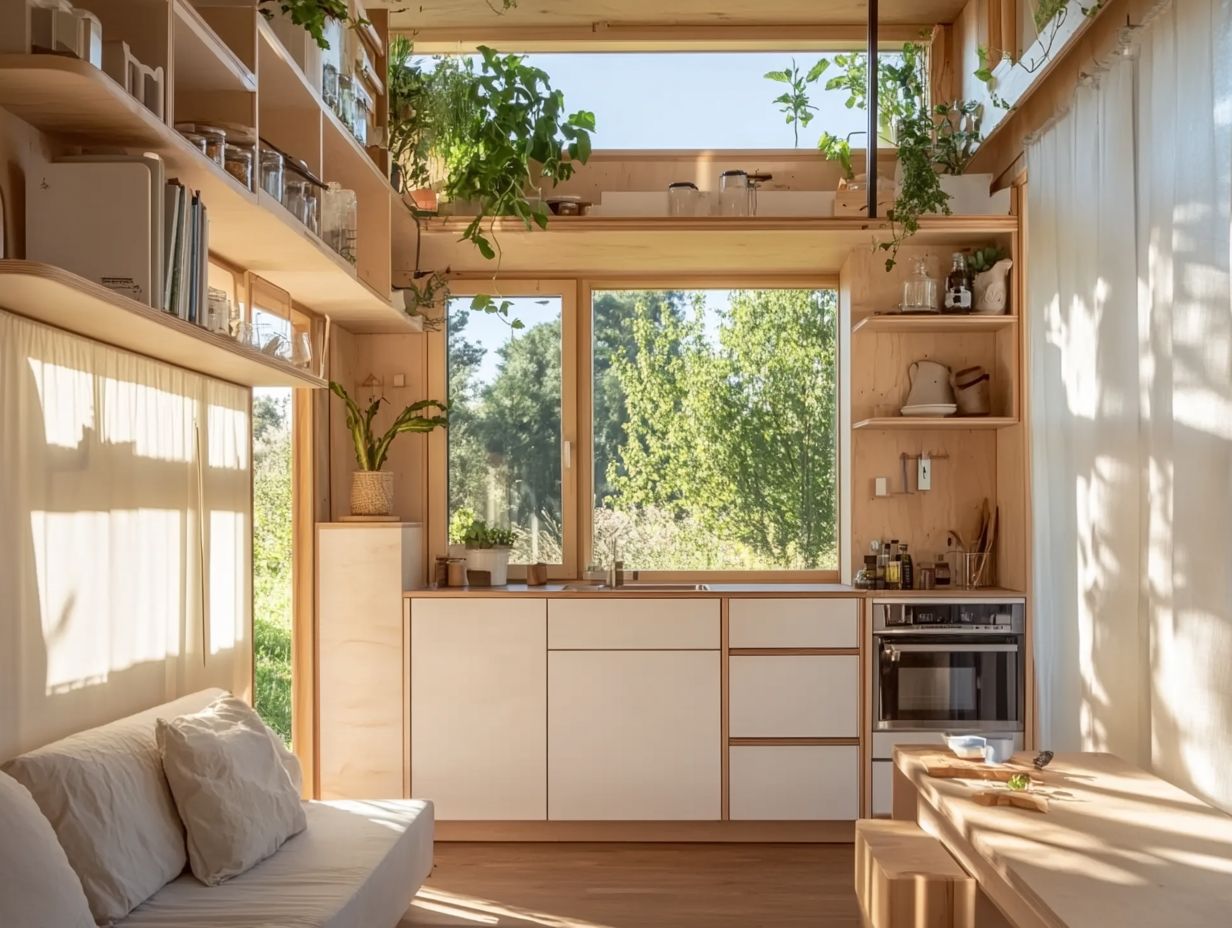
Simple projects include installing built-in shelving, using multipurpose furniture, and adding wall-mounted storage solutions.
2. How can I make my tiny house feel more spacious with DIY projects?
Use light, neutral colors and mirrors to create the illusion of space. DIY storage solutions can help maximize floor space, too.
3. Can I use recycled materials for DIY projects in my tiny house?
Yes! Recycled materials save money and add character. Consider using salvaged wood for shelves or repurposing old furniture.
4. Are there any DIY projects for maximizing kitchen efficiency in a tiny house?
Absolutely! Create a pull-out pantry, use pegboards for utensils, and install a magnetic knife holder. Think about your trailer layout when planning.
5. Can DIY projects help save energy in a tiny house?
Yes, Do-It-Yourself (DIY) projects can save energy in a tiny house. You can install energy-efficient LED lights and add weather stripping to doors and windows.
Creating DIY insulation solutions also helps manage climate control effectively.
6. What are some cost-effective DIY projects for maximizing tiny house efficiency?
Cost-effective DIY projects include using tension rods for hanging curtains and creating a vertical herb garden using a repurposed pallet. Shopping at secondhand stores can yield budget-friendly furniture and decor.
Platforms like Google and YouTube offer valuable tutorials and inspiration to help you succeed in your projects.

